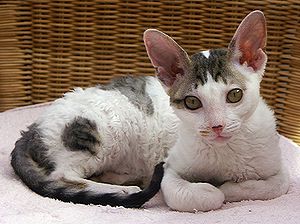Cornish Rex
| Cornish Rex | |
|---|---|

|
|
| Standard No. | |
| Shoulder height | |
| length | |
| Weight | Male: Ø kg female: Ø kg |
| allowed colors | |
| colors not allowed | |
| permitted coat drawing | |
| not allowed coat drawing | |
| List of cat breeds | |
Cornish Rex is a domestic cats - race . Their most distinctive feature is their curled fur. The first cat of this breed appeared in Cornwall in the early 1950s .
history
The first Rex cat appeared in Cornwall in the early 1950s , and was found in the middle of a litter of farm cats . They wanted to breed several of these curly cats, so the male was crossed with his mother, which supposedly resulted in even more Rex cats. The name Cornish Rex is derived from Cornwall. A few years later another cat with mole fur (= Devon Rex ) was discovered in Devonshire . Specimens of both breeds were then crossed, but the desired result was not achieved. "Rex" is surprisingly a term used in rabbit breeding and describes the animal's mole-like fur.
Appearance
The breed-forming characteristic is the curly or wavy fur, which is called " mole fur" , precisely because the head of hair is reminiscent of that of a mole. The hair is short and close-fitting, the guard hairs are only sparsely present and only indistinctly differ from the woolen hair. The guide hair is completely absent. Whiskers and eyebrows are curled. Of all known Rex cat breeds , the Cornish Rex is the most affected by hair changes.
The Cornish Rex is a slender cat with long straight legs. The tail is also long and slender. The head is wedge-shaped with a long nose, the ears are large and set high, they look like those of a bat . The eyes are medium-sized and oval. In her overall appearance she resembles the oriental shorthair .
The genetic defect that causes the breed-typical hair change is the same that the German Rex cat carries. It is inherited as an autosomal recessive trait. The mutation is in the LPAR6 gene, which codes for the "lysophosphatidic acid receptor 6". It is a premature breakdown of protein formation found in Cornish Rex and German Rex but not in cats with straight hair. LPAR6 is a G protein-coupled receptor that is responsible for the structural integrity of the hair shaft. A similar mutation in humans results in the woolly hair syndrome.
References
- ↑ Barbara Gandolfi, Hasan Alhaddad, Verena K. Affolter, Jeffrey Brockman, Jens Haggstrom, Shannon EK Joslin, Amanda L. Koehne, James C. Mullikin, Catherine A. Outerbridge, Wesley C. Warren, Leslie A. Lyons: To the Root of the Curl: A Signature of a Recent Selective Sweep Identifies a Mutation That Defines the Cornish Rex Cat Breed. In: PLoS One . Vol. 8, No. 6, 2013, e67105, doi: 10.1371 / journal.pone.0067105 .
- ↑ orpha.net
Web links
- Breed standard FIFe ( Memento of February 3, 2009 in the Internet Archive )

